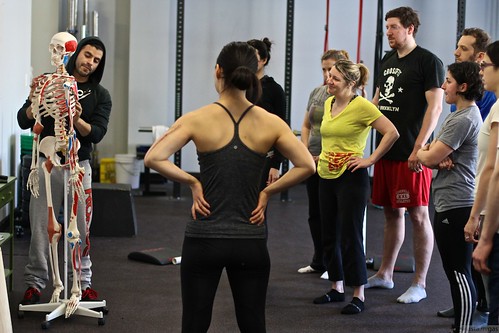
Today's article is about CFSBK’s Active Recovery (AR) class, which is essentially an hour of mobility and soft tissue maintenance that we offer four times a week. The original version of this program started in 2009 when we began hosting six-class workshops to more directly address the movement restrictions we were seeing in our membership. The few minutes of movement prep built into the beginning of group classes was proving insufficient in terms of instructing and enabling our members to really understand their restrictions and learn how to work on them. The goal of implementing specific AR sessions was to help our members establish a routine of DIY work outside of class so they could move and perform better in class.
While the original workshops were successful in terms of selling out and garnering positive feedback from attendees, we gradually realized that an open class format (similar to group classes) would decrease the barriers of entry, providing hour-long sessions that anyone could hop into for some soft tissue lovin’—as opposed to requiring a three-week commitment limited to the group of people who happened to get into the workshop. These classes have been enormously successful, and our members have seen dramatic improvements in their mobility as a result of both attending class and learning to mobilize regularly on their own.
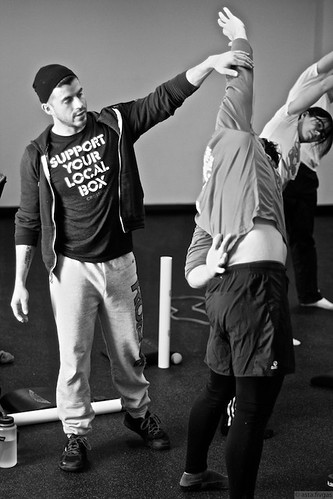 Membership Logistics
Membership Logistics
CFSBK members can attend one or more of our four weekly AR classes by either dropping in for $15, or by using the class as part of their weekly group class membership. Unlike our group classes (as discussed in our article “Screening Policies for New and Transfer Athletes”), AR is also open to the public. Every once in a while, members bring friends along or visiting athletes attend, but the vast majority of people are active CFSBKers. Despite the popularity of the workshop, we were a little unsure at first if people would actually show up for an hour of pure mobility, but attendance has been consistently high. In fact, part of the impetus for building our recent upstairs annex space was that Active Recovery classes were becoming so large. It’s typical for my Saturday AR classes to have upwards of 20 people in attendance.
This program is not only an asset for your members, but a valuable income stream for your affiliate that requires minimal equipment, with a footprint that can be easily managed based on your programming. Each class has a bunch of "regulars" who attend every week and have worked it into their weekly training routines, which is evidence of how important it is to membership.
Theory
I would be remiss not to mention how influential Kelly Starrett's work has been to our AR program. When Mobility|WOD launched in September of 2010 with the motto “All human beings should be able to perform basic maintenance on themselves,” CFSBK’s "tool box" of mobilization methods was much smaller than it is now, and our conceptual approach to dealing with movement issues was far less refined. Along with so many others—CrossFitters and other athletes alike—we are forever grateful for his contributions. I would highly recommend reading Kelly’s book Becoming a Supple Leopard: The Ultimate Guide to Resolving Pain, Preventing Injury, and Optimizing Athletic Performance to anyone interested in offering a class similar to Active Recovery. His oeuvre of m|WOD videos are also extremely helpful.
During AR classes and training, athletes will fire off a steady stream of questions about various mobilizations, the differences between particular methods, and about specific orthopedic issues they’re having. While it's not your responsibility to diagnose an injury, AR classes do create a space where those conversations come up much more readily, and you should have the skill set and knowledge to understand whether an issue is related to an open circuit fault, an over tension issue, an adaptation error, or perhaps some sort of pathology that is beyond your capacity to help with (such as SLAP tear).
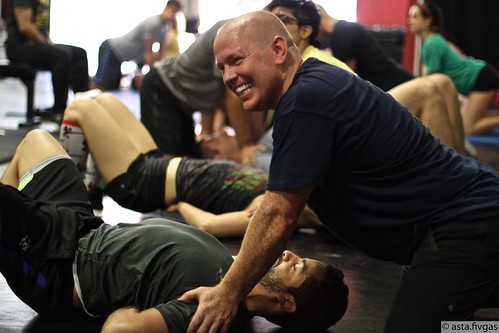 A basic knowledge of anatomy will also prove helpful—both with teaching mobilization and coaching in general. I recommend Anatomy of Movement by Blandine Calais-Germain, in which she presents not only basic anatomy, but also how joints and muscles actually work together during movement. The book provides a practical approach and welcome departure from the often overly-detailed and nuanced information in many anatomy and physiology texts (which are more appropriate for anatomy students and body workers, such as physical therapists).
A basic knowledge of anatomy will also prove helpful—both with teaching mobilization and coaching in general. I recommend Anatomy of Movement by Blandine Calais-Germain, in which she presents not only basic anatomy, but also how joints and muscles actually work together during movement. The book provides a practical approach and welcome departure from the often overly-detailed and nuanced information in many anatomy and physiology texts (which are more appropriate for anatomy students and body workers, such as physical therapists).
All this being said, even if your entire Active Recovery class consisted of couch stretch and foam-rolling peoples’ thoracic spines, you'd still be doing a world of good for your athletes and their mobility in class. Get on it.
Programming + Class Flow
Since we're catering to an open enrollment of CrossFitters and we've got an entire hour to work with, we keep these classes pretty broad and try to hit most basic positions and systems. I generally write out eight to 10 different mobilizations that I want to cover and usually have to add or delete a few things depending on the flow of the class.
Since I've already programmed what we're going to do, I start class by asking people to get the tools they're going to use that day so they're on hand when we need them. Sometimes I start with general movement prep like DROMs or something resembling a Crossfit-ified sun salutation, and sometimes we just get right into it. Below is the exact template for the class I ran last Saturday: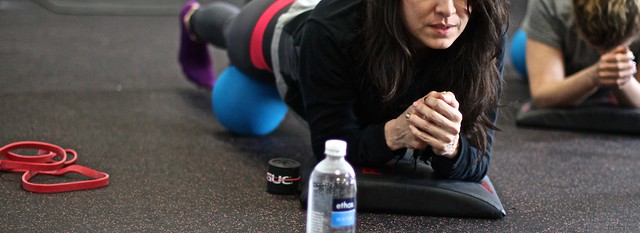
Equipment needed:
7" Orb or foam roller
LAX ball
Abmat
2" Thick PVC Section
Blue or red monster band
Partner Internal Rotation Stretch 2:00 each
Triceps Smash on PVC 3:00 each
2 Positions, chest down or on side to target different parts of your upper arm
Wrist and elbow partner distractions 1:00 each
Talk about shoulder and hand positions. Use free hand to spread fingers out.
Voodoo Floss Wrist 1:30 or so
Explain what compression bands are doing
Overhead Rib Mobilization with LAX ball or LAX Ball Pressure wave against wall 3:30 each
Athlete's choice on this one. Before this one show them their scapula on Chincy (our skeleton) and talk about where the lax ball goes and why its important to keep that tissue supple for efficient scapular movement.
Lateral Line
Foam Roll or Orb Thigh 4:00 each
Let people root around and hit medial, anterior and lateral aspects of thigh
Calve Mash 3:00 each
Lax Foot Mash 2:00 each
Tone
The role of the instructor involves making sure everyone maintains the correct positions and understands the objectives of each movement, and of course, managing the flow of the class. I try to teach one conceptual thing per class, such as reviewing a rule of mobility, explaining how the knee works in general terms that offer insight into how to care for it, or I might even talk about hydration or the bracing sequence. You have an entirely captive audience, so you should maximize what your athletes are getting out of the time, with the 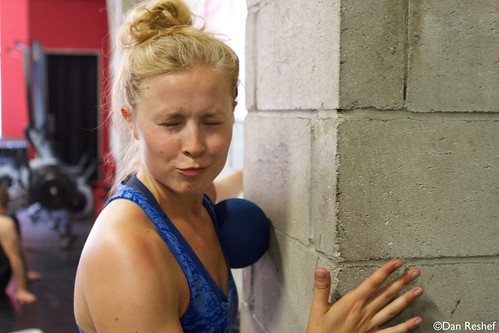 hopes that what you talk about and do in class blooms into the rest of their lives and athletic endeavors. Also… I'm a particularly chatty person and like to engage people in class, with the aim of helping everyone get to know each other better, have fun, and pay less attention to the discomfort of some of the more intense mobilizations. So, for example, maybe I'll ask one person what they did the previous evening and they’ll mention a restaurant, which leads to a group conversation about which restaurant has the best burger in town. Or maybe I'll pick a silly question similar to our Question of the Day, and throughout the hour, get each participant to answer. It doesn't really matter how the conversation starts; the most important component is that laughter happens at regular intervals during class. Remember that people will keep coming back to your gym not only because the instruction and programming are good, but because it's a FUN place to be.
hopes that what you talk about and do in class blooms into the rest of their lives and athletic endeavors. Also… I'm a particularly chatty person and like to engage people in class, with the aim of helping everyone get to know each other better, have fun, and pay less attention to the discomfort of some of the more intense mobilizations. So, for example, maybe I'll ask one person what they did the previous evening and they’ll mention a restaurant, which leads to a group conversation about which restaurant has the best burger in town. Or maybe I'll pick a silly question similar to our Question of the Day, and throughout the hour, get each participant to answer. It doesn't really matter how the conversation starts; the most important component is that laughter happens at regular intervals during class. Remember that people will keep coming back to your gym not only because the instruction and programming are good, but because it's a FUN place to be.
Closing Thoughts
As I already mentioned, Active Recovery classes will be a positive and welcomed addition to your gym, and provide another valuable income stream with minimal overhead costs. It’s a fabulous asset for your members because it teaches them how to take care of themselves and listen to their bodies in a more informed way. The classes also provide athletes with a place to go that directly relates to their CrossFit training and is different from any other mobility work, including yoga or massages, since it focuses on actively caring for and improving soft tissue health.
I recommend keeping the programming varied and comprehensive, and I especially recommend doing your homework so you’re ready when people inevitably start asking questions. One last plug? Perhaps most importantly, AR will create worthwhile, important conversations at your affiliate about how to get and be better—which is hopefully why you’re reading ITA, coaching CrossFit, or running an affiliate in the first place.
________________
 Testimonials
Testimonials
“When I was 17 I couldn't do anything athletic—in fact, the only Presidential fitness test I could pass was the sit-and-reach. I'm now 35 and can do a lot of fun movements in CrossFit, but a lifetime of sitting has robbed me of much of the mobility I used to have. I find AR to be absolutely essential not only to maintaining my ability to perform CrossFit movements, but also just to feel like a normal person and not a stiff mannequin. I've become a total AR evangelist and got my non-CrossFitting husband to join the cult too.”
—Stella Z.
"What I've come to realize is that AR class is actually ART class: Active Recovery Training. Whereas group classes constitute by far the bulk of my exercise, a weekly AR class represents only about a third of the time I spend stretching and mashing and flossing with rollers/orbs/lax balls/bands. AR class is where I go to build my active recovery toolbox in a environment that's as pleasant and social as CFSBK's group classes."
—Rich A.
"Going to Active Recovery has helped me in two ways. First, it can take me from creaky and tight to organized and more fluid in just 60 minutes. That's pretty miraculous in itself, but over the years A/R has also given me the tools, method and desire to be a persistent explorer of my own body, all the time, seeking out limitations and then figuring out how to intelligently address them."
—Michele K.